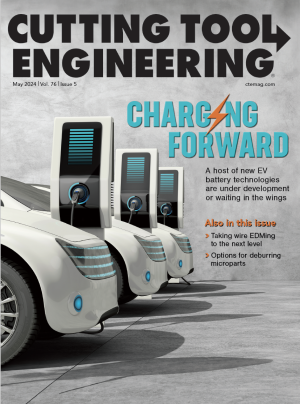When a company — an advertiser —offers to pay my way overseas to join 40 or so other industry media representatives from around the world for a special press event and tour, I go for two main reasons. First, it’s free. Second, given that it’s free the company must have something fairly significant to share. Spoiler, it did.
Dubbed “CERATIZIT Open Days 2024,” the trip included tours of the CERATIZIT Group’s factories in Reutte, Austria, the logistics and technical center in Kempten, Germany, and the innovation center in Balzheim, Germany. Though the event allowed the company to share news of several technological advancements, such as its additive manufacturing success with carbide, CERATIZIT’s larger, overarching message — its mission — was loud and clear: to increase material recycling and energy optimization to ensure a sustainable future for the hard metal and cutting tool industry.
The first step toward that end is to reach product carbon neutrality by 2025. That means CERATIZIT intends to reduce by 35% the carbon dioxide equivalent (CO2e) emissions of all greenhouse gases it uses to produce a product. By 2030, the goal is to reduce CO2e by 60%. And, by 2040, CERATIZIT plans to achieve net zero status, or a 90% reduction in CO2e.
As the company explained during the press tour, CERATIZIT has and is switching to green energy — its Reutte facilities will run on 50% green hydrogen beginning in 2025. Meanwhile, the company has been running production with 99% electricity from renewable sources since 2022. That move alone, according to CERATIZIT, helped the company reduce its corporate carbon footprint by more than 20%.
At the same time, CERATIZIT is working to reduce the use of virgin raw materials for tool making by increasing the share of recycled raw materials remaining in its carbide production chain to more than 95% by 2030. That percentage is based on the company’s scrap recycling rates of sintered products.
Just how close are they to achieving that goal? For a while there in 2023, the CERATIZIT Group reportedly ran tool production on almost 100% recycled materials. For the entire year, the company saw its use of recycled material climb to 80%.
And if that isn’t enough to grab your attention as it did mine, then perhaps the performance of these tools will at least raise an eyebrow. CERATIZIT’s new carbide grade CT-GS20Y consists of more than 99% recycled carbide recovered from decommissioned milling cutters, drills and solid carbide tools. During milling tests, the new grade was compared with well-established premium carbide grades. CT-GS20Y was found to be equal or better than the premium grade.
I share this information with you here not to promote one company or product over another. I am sharing this information because the worldwide cutting tool industry seems destined to follow suit as supply chain worries and climate regulations generate a growing interest in knowing the product carbon footprint (PCF) of each tool. And, to CERATIZIT’s credit, the company is offering a whitepaper on its own PCF classification system, which measures PCF in kg C02e/kg product. Their goal is simple: help the industry establish a common standard for calculating and classifying the carbon footprint of cutting tools, hard material solutions and tungsten carbide powders. (Obtain a copy of the whitepaper here: www.ceratizit.com
Contact Details
Related Glossary Terms
- gang cutting ( milling)
gang cutting ( milling)
Machining with several cutters mounted on a single arbor, generally for simultaneous cutting.
- milling
milling
Machining operation in which metal or other material is removed by applying power to a rotating cutter. In vertical milling, the cutting tool is mounted vertically on the spindle. In horizontal milling, the cutting tool is mounted horizontally, either directly on the spindle or on an arbor. Horizontal milling is further broken down into conventional milling, where the cutter rotates opposite the direction of feed, or “up” into the workpiece; and climb milling, where the cutter rotates in the direction of feed, or “down” into the workpiece. Milling operations include plane or surface milling, endmilling, facemilling, angle milling, form milling and profiling.
- sawing machine ( saw)
sawing machine ( saw)
Machine designed to use a serrated-tooth blade to cut metal or other material. Comes in a wide variety of styles but takes one of four basic forms: hacksaw (a simple, rugged machine that uses a reciprocating motion to part metal or other material); cold or circular saw (powers a circular blade that cuts structural materials); bandsaw (runs an endless band; the two basic types are cutoff and contour band machines, which cut intricate contours and shapes); and abrasive cutoff saw (similar in appearance to the cold saw, but uses an abrasive disc that rotates at high speeds rather than a blade with serrated teeth).
- tungsten carbide ( WC)
tungsten carbide ( WC)
Intermetallic compound consisting of equal parts, by atomic weight, of tungsten and carbon. Sometimes tungsten carbide is used in reference to the cemented tungsten carbide material with cobalt added and/or with titanium carbide or tantalum carbide added. Thus, the tungsten carbide may be used to refer to pure tungsten carbide as well as co-bonded tungsten carbide, which may or may not contain added titanium carbide and/or tantalum carbide.



